1963 Mexican Grand Prix race report: Clark leaves them standing
Jim Clark wins by over 90 seconds from Jack Brabham and Richie Ginther, lapping all but the podium finishers
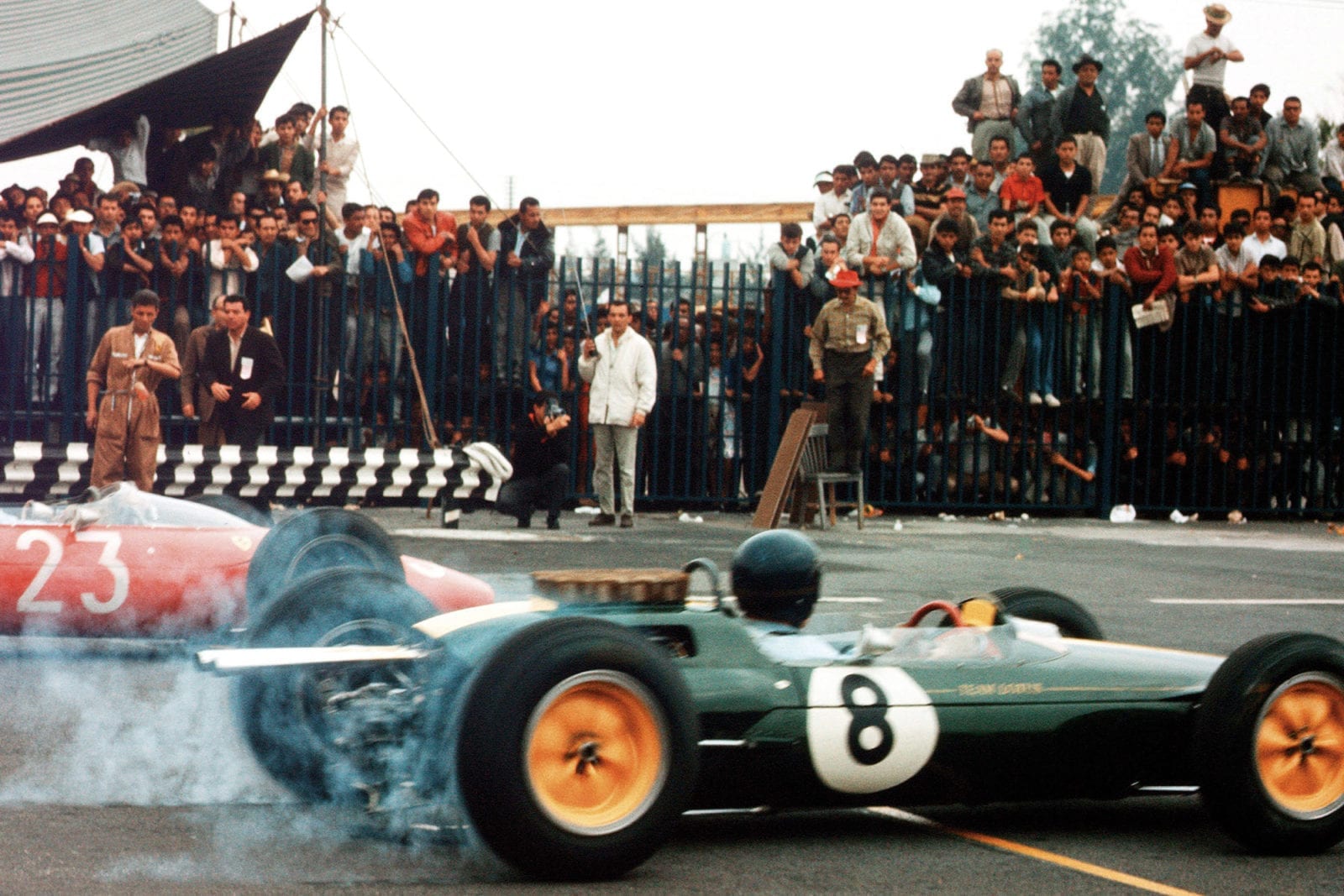
Clark sets off for his sixth win of the season
Motorsport Images
In 1962 the Mexican Automobile Club invited some GP drivers to participate in a Formula One race on the circuit at Mexico City. This year, with FIA approval, the race counts in the World Championship series and therefore attracted a big entry.
The circuit is situated in a 600-acre sports arena which consists of 48 football pitches, 55 baseball grounds, 100 basket-ball pitches four Olympic-size swimming pools, innumerable changing and locker rooms, children’s playgrounds, and the 5-kilometre race track. The area in which the track is built is perfectly flat, as is all Mexico City, this area being a dried-up lake bed. The land belonged to an Indian tribe and when it was confiscated the Indians were promised that their sacred burial ground would not be built on. So, behind the pits is a walled-off area in which there can be seen many weird grave markers.
One of the most impressive things at this circuit are the pits. Without a doubt, they are the best in the world for Grand Prix racing. Each pit garage is 30ft long by 15ft wide: At one end is the pit counter with a drop-down lockable flap; at the other end strong wire mesh doors, which can be locked. Right down one wall there is a long work bench with power points: At the entrance is a compressed air line and a water tap.
In one pit they were working on three cars at once and it wasn’t overcrowded. As there is a pit for each car, mechanics had plenty of room to lay out all their paraphernalia. The doors at the back open out into a large paddock where cars can be push-started, etc, and into which no private cars or members of the public are allowed, however much they are willing to pay.
The 5-kilometre circuit consists of, from the start-finish line, a straight with a tricky right followed immediately by a left, a short straight, another left-right, then a straight to an hairpin. From the hairpin a succession of four left and right slow curves lead to a short straight and the slightly banked 180° sweep before the pits. The section from the hairpin through the slow curves became known during the race as the “Mickey Mouse” section.
Another extraordinary feature at this circuit is the barometric pressure. The city of Mexico stands 7,400ft above sea level, and the normal barometer reading of 29.90in at sea level drops to 23.09 at this height. The main problem teams had to face was the mixture control. Last year when all the entries were on carburetters it was fairly simple to change jets until by a “suck-and-see” method a correct mixture was obtained. This year, however, most cars were using fuel injection and to weaken the mixture enough it was necessary to re-shape the metering cam.
Other than the cars, the altitude had its effect on the drivers and mechanics; all effort made the heart beat faster and left one very short of breath. The local people explained that the system adjusted itself in four to seven days but by that time most participants were on their way home.
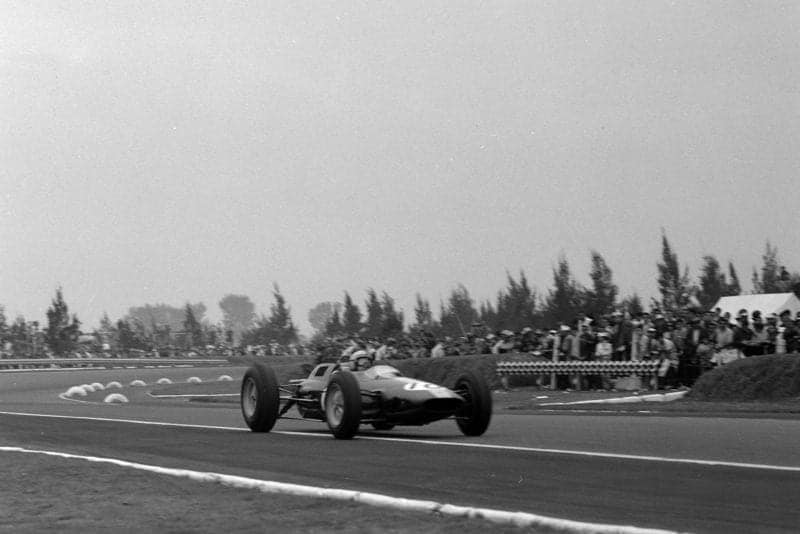
Rodriguez drove a third entry for Lotus
Motorsport Images
An excellent entry had been received. Coopers had two cars for McLaren and Maggs. The fuel trouble McLaren had suffered at Watkins Glen was due to the almost seized fuel pressure pump, so this had been replaced. Team Lotus had three cars. For Clark there was the car he has driven all season, Taylor was in the latest model still with the Hewland gearbox, while Pedro Rodriguez was to drive the carburetter model.
The Ferrari team had four cars, the three that had been at Watkins Glen, ie. a monocoque and two older cars, and a brand new monocoque flown straight from Modena. The new car was for Bandini, and outwardly there was no change from the first monocoque although minute alterations had been made to the geometry of both front and rear suspension. Surtees had decided to drive the older monocoque and the two older cars were for practice, or use if necessary.
BRMs had their two victorious cars from Watkins Glen for Hill and Ginther. The engines had both been swapped but, other than that, the cars were the same. Jack Brabham had his two cars for himself and Gurney. Jack’s car was using a flat crank engine while Gurney’s had the ordinary one. The mechanics had been unable to find the fuel trouble which had slowed Gurney at Watkins Glen but they had welded up the front wishbone mounting which had cracked in the United States Grand Prix.
Reg Parnell had three cars, a Lola-Climax for Masten Gregory, a Lotus-BRM for young Chris Amon, who had almost completely recovered from his Monza accident seven weeks previously. The third car, a Lotus-BRM, was for Hap Sharp to drive. ATS had brought the two cars they had at Watkins Glen, one with the gearbox hanging out the back, for Phil Hill, and the other with the inboard gearbox for Baghetti. The two engines had been sent back to Italy and arrived on the eve of practice, necessitating a night session before practice for the whole team. The engine fitting was made more difficult by the fact that a tremendous tropical thunderstorm had cut off the electricity and the whole job had to be performed by torch and headlights.
This completed the main teams, the rest were all single runners. BRP had a Lotus-BRM for Hall. Rob Walker had his Cooper-Climax for Bonnier; the flat-crank engine used at Watkins Glen had been replaced by a normal engine as the timing gears on the latter were not 100%. Siffert had his Lotus-BRM, the damaged drop gears having been replaced and the box rebuilt.
De Beaufort had his old but reliable Porsche. Centro Sud had arrived with their red BRM, complete with spare engine, spares and English BRM mechanic. The car was for Moises Solana, a local Mexican driver who, although almost unknown outside Mexico, none the less turned out to be quite a good driver, although not half as good as he thought himself. Last of the 22 entries was an American, Frank Dochnal. He had entered an old 4-cylinder Cooper-Climax, this being Maggs’ car before he drove a V8 car.
Qualifying

Solana was another additional Mexican entry
Motorsport Images
Before practice BRM team mechanics had fitted new metering cams to all the private entrant cars using their engines. Practice began at 1pm on Friday with everybody present and ready to go out. First away was Clark who, as holder of the lap record, 1min 59.7sec, set up last year, had a target to aim at. The only difference in the circuit was that the banked curve before the start-finish line had been flattened and smoothed off, but this was not expected to affect the times very much. Clark was followed by Bonnier, McLaren, Bandini and Taylor. As they were finishing their first lap and the rest were pulling out of the pits, officials slowed the cars down as a dog was reported on the track.
Clark was soon in his stride and in a few laps was down to 2min 05sec. Then he came into the pits complaining that he was unable to get maximum revs. Taylor followed him in, his car being unable to go over 9,400revs, even in low gears. One by one the cars returned to the pits with similar troubles and work of further mixture weakening went on in every pit. Brabham passed Dochnal’s old Cooper in front of the pits waving and pointing for the American to use his mirrors; one lap later the Cooper spun and damaged its rear suspension on the far side of the circuit, where it remained until the end of practice. While Clark’s car was being worked on, he went out in Taylor’s car for some laps, which was not noticed by the timekeepers.
ATS were in trouble. Hill’s car was not revving very well and changing the jets in the Webers improved this, but when it did rev, the driver’s shoulder was sprayed with hot oil from the breather. After very few laps, for which no times were given, Hill’s car was moved away to be worked on, and a little while later Baghetti’s car followed with oil circulation troubles.
Both BRMs were going well with times of around 2min 02sec, although Hill complained that his car was down on power, but this was remedied to a certain extent when it was found that two wires on the Lucas ignition system were crossed. Later, after the mixture had been properly balanced, Hill got down to nearly 2min dead. Graham was not feeling very well due to his front sinuses being filled with sea water from ski-ing falls at the lovely seaside resort of Acapulco.
Rodriguez had only done a few laps when the timing chain in his Climax engine broke, causing a lot of damage. Unfortunately, Lotus had no spare carburetter engine, so the mechanics started stripping the engine down to see if it could be repaired from US GP engines held by other teams, but not wanted for this race. Taylor’s Lotus had found some more revs. but was wheeled away to have the gear ratios changed.
The BRP car had developed a water weep from the chassis and was welded up during practice. Both Brabhams were going fairly well with Gurney somewhat faster than Brabham. Coopers were working on the mixture for a long time but in the end McLaren got down to 2min 02.3sec. The Ferrari team were not very happy, as they were finding it difficult to get the right mixture, and it was a long time before Surtees really got going and then he was unable to get below 2min.
Clark’s car was brought out again halfway through practice and he proceeded to do some very quick laps, culminating in 1min 58.8sec, a speed of 151.51kph. Of the private entries, Bonnier, Siffert and Solana had 1sec between them. Amon was not able to get back into the swing of things very quickly, as his engine was playing up, while Gregory was complaining that the oil pressure on the Lola was still surging as it had done at Watkins Glen. On close examination it was found that an oil pipe on the tank which had been made up after the Monza crash was missing, so the mechanics set about fitting it for the next day.
An hour from the official end of practice light rain began to fall and most cars were pushed away to be prepared for Saturday’s 4-hour training session. At 5pm the track was cleared and the first practice was over.
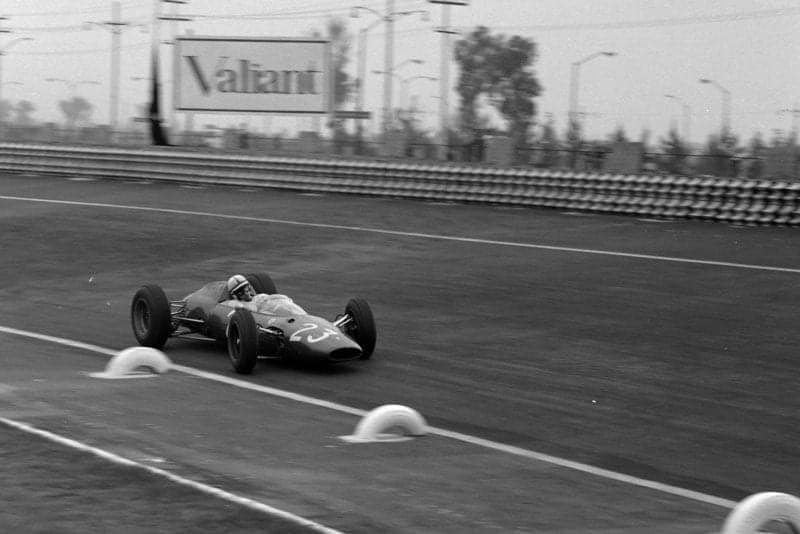
Ferrari’s Surtees needed an engine change overnight
Motorsport Images
Overnight a lot of activity went on in the garages. Lotus mechanics had managed to obtain a length of Renolds’ bicycle chain from a shop in town and they set about rebuilding the damaged engine. After replacing the four exhaust valves and re-assembling, the car was to have started just before practice but unfortunately the timing was 180° out so nothing happened and the timing had to be reset.
Ferrari changed Surtees’ engine overnight, as the fuel pump was not working properly. Frank Dochnal tried to repair his 4-cylinder Cooper-Climax but when he hit the bank he did more damage than could easily be repaired with a hammer and welding torch. Dochnal blamed the Goodyear tyres for the cause of the accident, saying they had no grip in the rain at all.
“Lotus mechanics had managed to obtain a length of Renolds’ bicycle chain from a shop in town and they set about rebuilding the damaged engine”
ATS worked all night again tearing the cars to pieces. They found that in the few laps Hill had done the bearings were beginning to break up. The same trouble was found on Baghetti’s car. After Monza, two extra scavenge pumps were fitted because excess oil in the sump was losing power. The sump was also dropped 8mm. Since this modification was done there had been consistent trouble with bearings and oil-pressure pumps. Overnight the two extra pumps were removed in the hope that the cars would keep going. Maggs’ Cooper had cracked the clutch housing, a trouble not new this year. A welded-up spare carried for such emergencies was fitted.
As time for practice to begin drew near, the rain began to fall, and with the exception of two quarter-hour breaks and half an hour at the end, it poured all afternoon. For 15 minutes after the track was opened no-one moved, then Solana went out in the Centro Sud BRM and one lap later he was joined by P Hill and Baghetti. The pace was slow as parts of the track had large, deep puddles lying in awkward places. Ginther was next out, half an hour after the start, and consistently improved on a 2 1/2-min first lap, down to almost 2min 20sec.
As the rain eased to an English drizzle, Amon, Graham Hill and Surtees went out. After only two laps Graham Hill’s car suddenly slowed violently in front of the pits and he came in at the end of the lap muttering about dogs on the track. This dog trouble cropped up several times during practice, which caused drivers some concern. While the rain was falling heavily, Solano, due to the large number of laps he did, was fastest in the first hour. Several times while he was thrashing round, the pit signalled him in but he ignored all signals.
The ATS was sounding a bit crisper than it did on the first practice but now Phil Hill was having gear-shift trouble. As he changed down the change from 3rd to 2nd could only be made after much shaking of the lever. During the next ease-up of the rain Clark made a short appearance and in only a few laps was 4sec faster than anyone else, with a time of 2min 10.6sec. Taylor did a few laps, getting down to 2min 18sec, when a knock in 1st gear, which he used at the hairpin, brought him in, to find that one tooth on 1st gear had broken off and to discover that there was no spare.
Both Hall in the BRP Lotus-Climax and Gurney in the Brabham were in the garages with gearbox trouble and it was nearly the end of practice before they emerged. Rodriguez’ engine was started but no oil pressure came up on the pressure gauge, so the engine was removed and the oil-pump drive was found to be broken. This engine, which is a long-stroke Climax as compared to Clark’s and Taylor’s, should rev at 1,000 revs down on the short-stroke units in the other two Team Lotus cars. Unfortunately Rodriguez didn’t believe his instructions, thinking he was being deliberately slowed down and therefore, until he retired at Watkins Glen, he consistently over-revved, which was no doubt the cause of his troubles in Mexico.
As practice was coming to an end parts of the track began to dry up and there was a general exodus from the pits to make the most of the last few minutes. Absent from this bunch was Clark, who was suffering from the same trouble that Graham Hill had had the previous day. The two Coopers had not been out until the end of practice and after only a few laps Maggs failed to turn up, due to a broken oil-pump drive, which meant some hours’ night work for the mechanics. Fastest during this second practice period was Jack Brabham, who was the only driver to improve on his previous day’s time, with a time of 2min 03.6sec.
Race
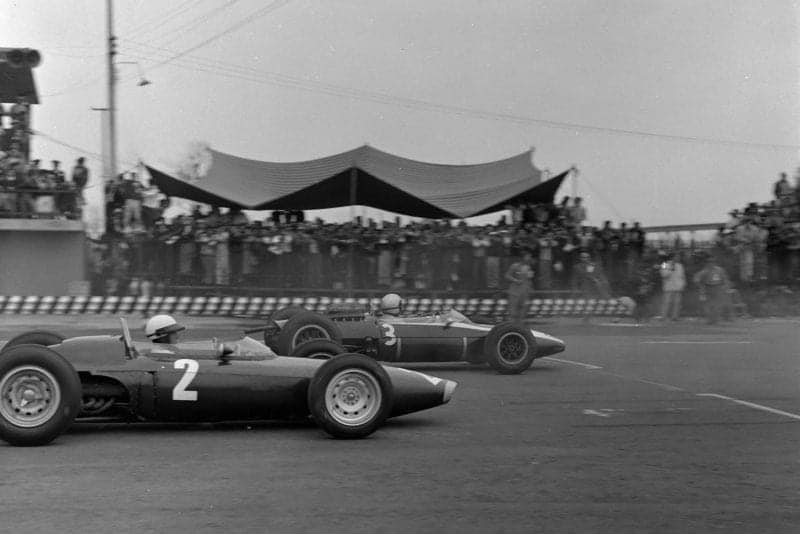
Ginther (foreground) and McLaren hare off the start line
Motorsport Images
Race day was overcast but not actually raining. Clark’s gearbox had been stripped and rebuilt to stop it jumping out of 2nd gear. Taylor was not going to use 1st gear due to the loss of the tooth. The Rodriguez Lotus became a runner at 4am on race morning. Maggs had borrowed Walker’s flat-crank engine, which was already a little tired since it ran the whole of the United States Grand Prix. Ferrari warmed up one of the practice cars and put number 23 on the side but a water leak on the monocoque was cured and the older car was pushed away.
The cars were wheeled out to the line and the drivers did a lap in the courtesy Fords they were using. On arriving back at the pits they all shook hands with the President of Mexico and then most of them did a warming-up lap. The rain that was forecast tried to start but it never developed into more than a few spots.
“On the line Surtees asked for his tyre pressures to be lowered but Foghieri said ‘No’ and Surtees had no time to argue”
On the line Surtees asked for his tyre pressures to be lowered but Foghieri said “No” and Surtees had no time to argue. The flag dropped at 2:30pm and the 2nd Mexican Grand Prix was under way. Clark leapt into an immediate lead, while behind him Hill’s BRM jumped out of gear and he lost valuable time re-engaging 1st gear. At the end of the first lap the order was Clark, Surtees, Gurney, McLaren, Ginther, Brabham, Bandini, Hill, Gurney and Rodriguez, the latter having moved up from 20th place on the grid to 10th place. In getting there he went sideways in front of Siffert, who spun and went over the rough grass, which pulled the lead off the fuel pump, which meant a pit stop at the end of his first lap.
On the next lap the gap started to open between Clark and the rest of the field. Gurney moved into second place with Surtees dropping behind him. Ginther passed McLaren into fourth place, and the field behind was already beginning to open up. On lap three the first three were unchanged, but Brabham moved past McLaren into fifth place, and two laps later he passed Ginther into fourth position. On lap three Baghetti came into the pits with a badly misfiring engine and after a few adjustments he went out again. Whatever the trouble was with his carburetters the mechanics could not cure it and he came in again on the eighth lap and was pushed into the paddock.
A short while later he re-appeared and continued for one lap, made a pit stop, and was finally told to retire on his 11th lap by the organisers who said he could not re-appear once he had gone to the paddock.
At the front things were beginning to settle down. Clark had a reasonable lead over Gurney who was well ahead of Surtees. Then came a longish gap with Brabham, Ginther and McLaren close together. Behind these three came Graham Hill, just leading Bandini, then another short gap with Rodriguez, Bonnier and Maggs, with a small gap between each. Next come Gregory and Solana, the latter getting past Gregory on the fourth lap and being re-passed on the next lap.
For several laps the lead remained constant but on the eighth lap Maggs pulled into the pits to retire when the bearings went on his borrowed engine. On the next lap Amon pulled into the pits and retired. His engine was losing so much power it would only just pull 4th gear on the straight. After the first two laps Graham Hill got past Bandini but the Ferrari driver never let the BRM get away and on the 12th lap he passed and started to pull away. Also on lap 12 Bonnier limped into the pits with a puncture in his left-hand rear tyre, and this dropped him from 10th to 16th place, just behind Phil Hill, whom he passed by on the next lap.
Surtees, lying third, did not seem very happy. On the long fast curve before the pits he was understeering to such an extent that blue smoke was pouring from his left front tyre for almost 200 yards towards the end of the bend. With this type of handling he was unable to stop Brabham passing him on the 15th lap. Four laps later the Ferrari came into the pits to have the rear tyres let down; after air had been let out, Surtees found the starter would not work. As the car was being push-started officials stepped in and refused to let him leave the pit area, so after a few more tries at starting, the car was wheeled away. The reason for the bad handling was that the front suspension was slowly collapsing and the car was hitting the stops all round the circuit.

Taylor’s was a retiree, but secured a sombrero as consolation
Motorsport Images
On the same lap as Surtees went out, Taylor retired, not with the gearbox trouble he expected but with a broken cam follower and big-end bearings rattling badly. G Hill passed Bandini on the 26th lap and remained ahead. On lap 23 Masten Gregory, who had been lying ninth and 10th for some laps, came into the pits with a rear radius arm dangling on the ground. The bolt fixing it to the chassis had broken and it could not be replaced.
In the lead Clark was still keeping up the tremendous pace he started with, consistently lapping in 1min 59sec. On the 26th lap he was 25sec ahead of Gurney, who was 13sec ahead of Brabham. Next, 1min behind Clark, came Ginther and McLaren, and 4sec behind them came Hill and Bandini. Eighth on the 26th lap was Rodriguez, who pulled into the pits with smoke pouring from the back of his car. The upper link and shock-absorber mounting had broken away from the monocoque, letting the whole car twist to a peculiar angle. This is the oldest monocoque and it is the first time there has been a failure of this sort on these cars.
“Rodriguez pulled into the pits with smoke pouring from the back of his car”
As the race moved towards the half-way stage McLaren began to slow and G Hill and Bandini both swept past him. Next lap the Cooper pulled into the pits and it was out with a broken camshaft having completed 30 laps. The field was now reduced to 13 cars. Last was still Siffert who had lost so much time in the early stages, with de Beaufort in front of him. Siffert lost a bit more time by spinning wildly on the last curve of the Mickey Mouse section, but he kept his engine running and was soon off again.
Phil Hill was lying 10th and sounding very rough. Sharp and Hall were in eighth and ninth places, the latter sounding a little rough on occasions. Solana was in seventh place and driving very consistently. The first six places were still the same, Hill using all the road to keep ahead of Bandini and at the same time he was having to hold the gear lever in position or else it jumped straight out of gear.
At the half-way stage Gurney began to have his usual trouble of fuel starvation; the fuel pressure dropped from 60 to 40lb and as he began to misfire Brahham gained slowly on him and on the 34th lap passed into second place. Two laps later Bandini suddenly went on to five cylinders, sounding exactly the same as Surtees had at Watkins Glen. He pulled into the pits and retired on his 36th lap. Bonnier, who had slowly been catching up after his pit stop, passed Hall on the 33rd lap, Sharp on the 38th lap and Solana on the 42nd lap, putting him in sixth place. On the same lap Ginther caught Gurney’s sick Brabham and passed into third place, and the BRM driver, like his team-mate, was having to hold the car in gear.
Phil Hill, who was popping and banging lower down in the field, failed to turn up on his 41st lap. A lower rear wishbone mounting broke away from the chassis, with the resultant retirement in the “Mickey Mouse” section.
On lap 45 Gurney came into the pits with fuel all over his feet. To try to stop the misfiring he had turned on the spare fuel tank but no tank was fitted so the fuel ran out of the main tanks over his feet. Having got the taped-up tap on he was unable to turn it off, and had to come in for this to be done.
Siffert’s progress at the back of the field had brought him up to de Beaufort, whom he passed on the 48th lap. On the 56th lap Solana’s engine went sick and Senor Dei nearly had a fit when his BRM limped past the pits with oil and smoke pouring from it. Next lap it crept into the pits with the tappets broken up and retired, to the disgust of Solana’s family, who wanted it to creep on to the finish. This now brought the race almost to its conclusion. Bonnier caught Gurney and passed him into fifth place.
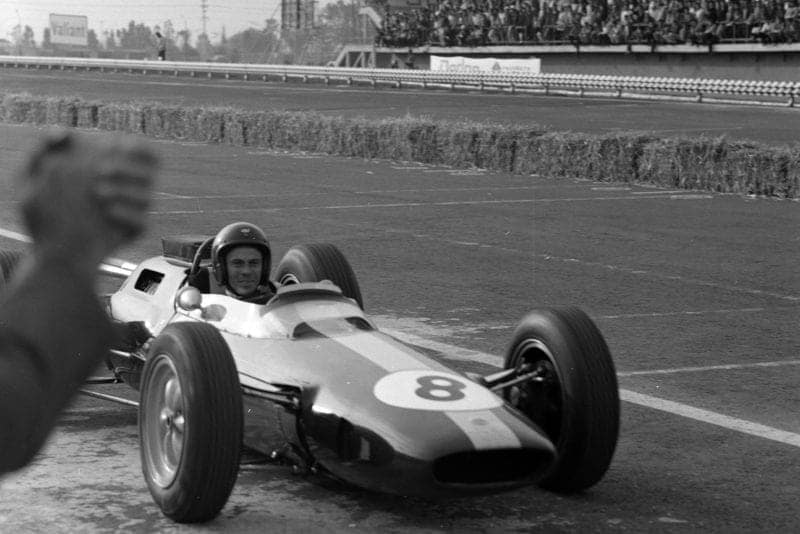
Clark took his sixth win in a dominant season
Motorsport Images
Hill spun on lap 59 just after the hairpin and lost 16sec on that lap, which enabled Clark to close up to lap him.
When Clark took the chequered flag only three cars were on the same lap. Brabham was second, 1min 40sec behind, with Ginther 13sec behind him. Fourth was Graham Hill, who was just lapped by 3sec. The race was won at a speed of 150.125kph and Clark also made the fastest lap, 1min 58.1sec, a speed of 152.413kph.
A satisfactory race, although not exciting, but a race which produced a host of technical difficulties not found in any Grand Epreuve.
